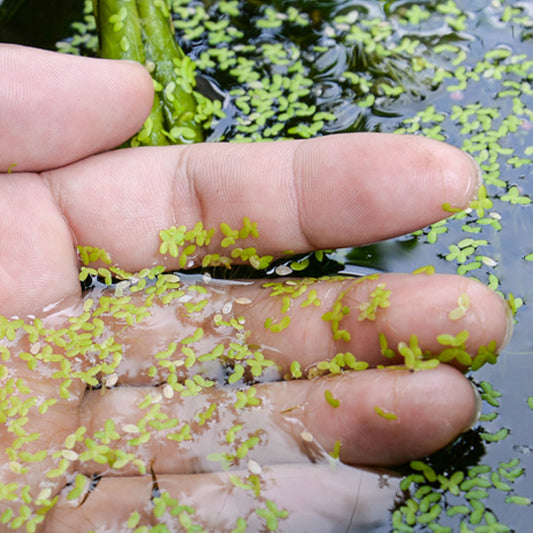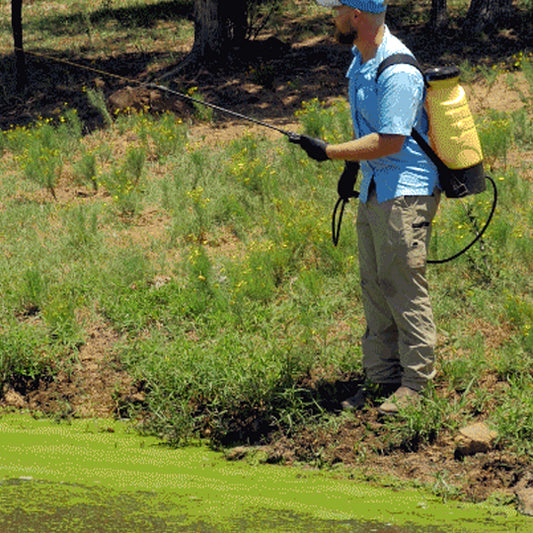Benefits of Chelated Copper Algaecide

Algae can be a major problem for small bodies of water, and because it can take over so quickly, it needs to be controlled in a safe and effective manner. Most people are familiar with the historically used algaecide, copper sulfate. Copper sulfate has been used in ponds for generations now with few changes.
Chelated copper works as a well or better than copper sulfate. Chelated copper is effective on both filamentous and planktonic algae in a wide range of fresh water applications. Upon application, it starts to work immediately and works extremely well—it’s far more effective than copper sulfate. When applied, it stays active (suspended in the water column) longer, rather than immediately sinking to the bottom. This allows you to use less copper, and take a more precise route to dealing with the problem.
Chelated copper uses less elemental copper then copper sulfate.
Technical aspects of chelated copper are:
- Chelated copper provides increased infusion (passive transport not facilitated active) of copper into the target algae biomass to act on multiple internal modes of action and elicit greater algaecide activity
- Chelated copper provides effectiveness independent of environmental conditions, growth characteristics and water chemistries
- Chelated copper can increase the stability of copper in the water column by decreasing the potential for precipitation with inorganic compounds
- Chelated copper products can have a greater affinity for the target species and control at lower treatment copper concentrations
- Chelated copper has documented decreased toxicity to non-target fish/invertebrate species
- SePRO algaecides are designed to enhance toxicity to and uptake by the target biomass subsequently decreasing available copper to non-target organisms and decreasing environmental burden.
In addition, the body of water treated with chelated copper can be used for swimming, fishing, watering livestock, irrigating turf or ornamental plants right after application. As you can see, these benefits make chelated copper a more technical choice for your algae control needs.

Watermeal: What It Is and What To Do About It
Where Does Watermeal Come From?
Watermeal is common in nutrient-rich, highly productive backwaters of wetlands, swamps, and other calm, shallow water. Watermeal generally pops up around the edges of a body of water in the beginning of the spring season and will begin to spread more quickly as summer gets closer. It can be introduced through transfer by waterfowl, turtles and other local fauna or by overflow of water from an infested site to a downstream water body.
The Problem with Watermeal
Some fish—like tilapia—are known to eat it, along with ducks, but it isn’t considered an important food. As watermeal covers more and more of a pond’s surface, it begins to block out sunlight to submerged plants, which will in turn reduce or prevent their growth. It can also reduce the levels of oxygen that is getting into the water, which can harm fish or live organisms.
Treating Watermeal
Because it is one of the most difficult invasive species to deal with, getting watermeal under control can be a challenge. And if it’s not handled right away, it can take over the entire surface of water. Because it’s easy to recognize, you should be able to get treatment in as soon as you spot it.
Depending on climate factors and how quickly it’s spreading, you may experience a thin layer of it, or a thick, chunky mat that covers the water completely. Because of its density, applying a simple spray herbicide won’t do and it usually needs in-water herbicide treatment for best results
Before it overruns your entire surface, treat at an early growth stage with effective watermeal herbicides such as Sonar® or Galleon®. Even with strong herbicide management, watermeal can be a persistent problem in productive ponds. In highly productive ponds with a history of watermeal issues, consider phosphorus inactivation with Phoslock to limit nutrient availability and reduce watermeal growth.




